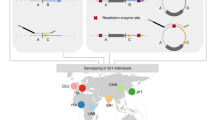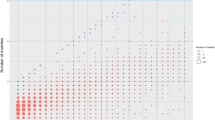Abstract
We compared the chromosomal breakpoints of evolutionary conserved and constitutional inversions. Multicolor banding and human-specific bacterial artificial chromosomes were applied to map the breakpoints of constitutional pericentric inversions on human chromosomes 2 and 9. For the first time, we present a high-resolution analysis of the breakpoint regions, which are characterized by gene destitution, co-localization with fragile sites, multitude repeats as well as pseudogenes and, remarkably, a large sequence homology to the opposite breakpoint. In contrast, evolutionary inversion breakpoints lack such extensive cross-hybridizing regions and are often associated with fragile sites of the genome and low-copy repeats. These molecular characteristics gave evidence for different types of inversion formation and indicate that evolutionary inversions cannot originate from constitutional inversions like those of chromosomes 2 and 9. Finally, the constitutional inversion breakpoints were investigated on three different great ape species and on four test persons each bearing the same cytogenetically determined inversion on chromosomes 2 and 9, respectively. Our data indicate the existence of different molecular breakpoints for the two variant chromosomes.






Similar content being viewed by others
References
Ait-Allah A, Ming P, Salem H, Reece E (1997) The clinical importance of pericentric inversion of chromosome 9 in prenatal diagnosis. J Matern Fetal Invest 7:126–128
Dennehey BK, Gutches DG, McConkey EH, Krauter KS (2004) Inversion, duplication and changes in gene context are associated with human chromosome 18 evolution. Genomics 83:493–501
Di Giacomo MC, Cesarano C, Bukvic N, Manisali E, Guanti G, Susca F (2004) Duplication of 9 p11.2-p13.1: a benign cytogenetic variant. Prenat Diagn 24:619–622
Djalali M, Steinbach P, Bullerdiek J, Holmes-Siedle M, Verschraegen-Spae MR, Smith A (1986) The significance of pericentric inversions of chromosome 2. Hum Genet 72:32–36
Dutrillaux B (1979) Chromosomal evolution in primates: tentative phylogeny from Microcebus murinus (Prosimian) to man. Hum Genet 48:251–314
Fan Y, Linardopoulou E, Friedman C, Williams E, Trask BJ (2002) Genomic structure and evolution of the ancestral chromosome fusion site in 2q13-2q14.1 and paralogous regions on other human chromosomes. Genome Res 12:1651–1662
Gardner R, Sutherland G (2003) Chromosome abnormalities and genetic counseling, 3rd edn. Oxford University Press, Oxford
Goidts V, Szamalek JM, Hameister H, Kehrer-Sawatzki H (2004) Segmental duplication associated with the human-specific inversion of chromosome 18: a further example of the impact of segmental duplications on karyotype and genome evolution in primates. Hum Genet 115:116–122
Hey J (2003) Speciation and inversions: chimps and humans. Bioessays 25:825–828
Humphray SJ, Oliver K, Hunt AR, Plumb RW, Loveland JE, Howe KL, Andrews TD, Searle S, Hunt SE, Scott CE, Jones MC, Ainscough R, Almeida JP, Ambrose KD, Ashwell RI, Babbage AK, Babbage S, Bagguley CL, Bailey J, Banerjee R, Barker DJ, Barlow KF, Bates K, Beasley H, Beasley O, Bird CP, Bray-Allen S, Brown AJ, Brown JY, Burford D, Burrill W, Burton J, Carder C, Carter NP, Chapman JC, Chen Y, Clarke G, Clark SY, Clee CM, Clegg S, Collier RE, Corby N, Crosier M, Cummings AT, Davies J, Dhami P, Dunn M, Dutta I, Dyer LW, Earthrowl ME, Faulkner L, Fleming CJ, Frankish A, Frankland JA, French L, Fricker DG, Garner P, Garnett J, Ghori J, Gilbert JG, Glison C, Grafham DV, Gribble S, Griffiths C, Griffiths-Jones S, Grocock R, Guy J, Hall RE, Hammond S, Harley JL, Harrison ES, Hart EA, Heath PD, Henderson CD, Hopkins BL, Howard PJ, Howden PJ, Huckle E, Johnson C, Johnson D, Joy AA, Kay M, Keenan S, Kershaw JK, Kimberley AM, King A, Knights A, Laird GK, Langford C, Lawlor S, Leongamornlert DA, Leversha M, Lloyd C, Lloyd DM, Lovell J, Martin S, Mashreghi-Mohammadi M, Matthews L, McLaren S, McLay KE, McMurray A, Milne S, Nickerson T, Nisbett J, Nordsiek G, Pearce AV, Peck AI, Porter KM, Pandian R, Pelan S, Phillimore B, Povey S, Ramsey Y, Rand V, Scharfe M, Sehra HK, Shownkeen R, Sims SK, Skuce CD, Smith M, Steward CA, Swarbreck D, Sycamore N, Tester J, Thorpe A, Tracey A, Tromans A, Thomas DW, Wall M, Wallis JM, West AP, Whitehead SL, Willey DL, Williams SA, Wilming L, Wray PW, Young L, Ashurst JL, Coulson A, Blocker H, Durbin R, Sulston JE, Hubbard T, Jackson MJ, Bentley DR, Beck S, Rogers J, Dunham I (2004) DNA sequence and analysis of human chromosome 9. Nature 429:369–374
Kehrer-Sawatzki H, Schreiner B, Taenzer S, Platzer M, Müller S, Hameister H (2002) Molecular characterization of the pericentric inversion that causes differences between chimpanzee chromosome 19 and human chromosome 17. Am J Hum Genet 71:375–388
Kehrer-Sawatzki H, Sandig CA, Goidts V, Hameister H (2005) Breakpoint analysis of the pericentric inversion between chimpanzee chromosome 10 and the homologous chromosome 12 in humans. Cytogenet Genome Res 108:91–97
Liehr T, Thoma K, Kammler K, Gehring C, Ekici A, Bathke KD, Grehl H, Rautenstrauss B (1995) Direct preparation of uncultured EDTA-treated or heparinized blood for interphase FISH analysis. Appl Cytogenet 21:185–188
Liehr T, Heller A, Starke H, Rubtsov N, Trifonov V, Mrasek K, Weise A, Kuechler A, Claussen U (2002) Microdissection based high resolution multicolor banding for all 24 human chromosomes. Int J Mol Med 9:335–339
Locke DP, Archidiacono N, Misceo D, Cardone MF, Deschamps S, Roe B, Rocchi M, Eichler EE (2003) Refinement of a chimpanzee pericentric inversion breakpoint to a segmental duplication cluster. Genome Biol 4:50
Maresco DL, Chang E, Theil KS, Francke U, Anderson CL (1996) The three genes of the human FCGR1 gene family encoding Fc gamma RI flank the centromere of chromosome 1 at 1p12 and 1q21. Cytogenet Cell Genet 73:157–163
Marzella R, Viggiano L, Ricco AS, Tanzariello A, Fratello A, Archidiacono N, Rocchi M (1997) A panel of radiation hybrids and YAC clones specific for human chromosome 5. Cytogenet Cell Genet 77:232–237
Miro R, Clemente IC, Fuster C, Egozcue J (1987) Fragile sites, chromosome evolution and human neoplasia. Hum Genet 75:345–349
Mrasek K, Heller A, Rubtsov N, Trifonov V, Starke H, Rocchi M, Claussen U, Liehr T (2001) Reconstruction of the female Gorilla gorilla karyotype using 25-color FISH and multicolor banding (MCB). Cytogenet Cell Genet 93:242–248
Navarro A, Barton NH (2003) Chromosomal speciation and molecular divergence-accelerated evolution in rearranged chromosomes. Science 300:321–324
Nickerson E, Nelson DL (1998) Molecular definition of pericentric inversion breakpoints occurring during the evolution of humans and chimpanzees. Genomics 50:368–372
Park JP, Wojiski SA, Spellman RA, Rhodes CH, Mohandas TK (1998) Human chromosome 9 pericentric homologies: implications for chromosome 9 heteromorphisms. Cytogenet Cell Genet 82:192–194
Pevzner P, Tesler G (2003) Genome rearrangements in mammalian evolution: lessons from human and mouse genomes. Genome Res 13:37–45
Richard F, Lombard M, Dutrillaux B (2000) Phylogenetic origin of human chromosomes 7, 16 and 19 and their homologs in placental mammals. Genome Res 10:644–651
Rieseberg LH, Livingstone K (2003) Evolution. Chromosomal speciation in primates. Science 300:267–168
Ruiz-Herrera A, Garcia F, Giulotto E, Attolini C, Egozcue J, Ponsa M, Garcia M (2005) Evolutionary breakpoints are co-localized with fragile sites and intrachromosomal telomeric sequences in primates. Cytogenet Genome Res 108:234–247
Samonte RV, Eichler EE (2002) Segmental duplications and the evolution of the primate genome. Nat Rev Genet 3:65–72
Sankoff D, Deneault M, Turbis P, Allen C (2002) Chromosomal distributions of breakpoints in cancer, infertility and evolution. Theor Popul Biol 61:497–501
Shaffer LG, Lupski JR (2000) Molecular mechanisms for constitutional chromosomal rearrangements in humans. Annu Rev Genet 34:297–329
Shimada MK, Kim CG, Kitano T, Ferrell RE, Kohara Y, Saitou N (2005) Nucleotide sequence comparison of a chromosome rearrangement on human chromosome 12 and the corresponding ape chromosomes. Cytogenet Genome Res 108:83–90
Smeets DF, van de Klundert FA (1990) Common fragile sites in man and three closely related primate species. Cytogenet Cell Genet 53:8–14
Stankiewicz P, Lupski JR (2002) Molecular-evolutionary mechanisms for genomic disorders. Curr Opin Genet Dev 12:312–319
Starke H, Seidel J, Henn W, Reichardt S, Volleth M, Stumm M, Behrend C, Sandig KR, Kelbova C, Senger G, Albrecht B, Hansmann I, Heller A, Claussen U, Liehr T (2002) Homologous sequences at human chromosome 9 bands p12 and q13-21.1 are involved in different patterns of pericentric rearrangements. Eur J Hum Genet 10:790–800
Sutherland GR (2003) Rare fragile sites. Cytogenet Genome Res 100:77–84
Sutherland GR, Baker E (2003) Forgotten fragile sites and related phenomena. Cytogenet Genome Res 100:89–91
Teebi AS, Gibson L, McGrath J, Meyn MS, Breg WR, Yang-Feng TL (1993) Molecular and cytogenetic characterization of 9p-abnormalities. Am J Med Genet 46:288–292
Verma RS, Babu A (1989) Human chromosomes—manual of basic techniques. Pergamon, New York
Weise A, Starke H, Mrasek K, Claussen U, Liehr T (2005) New insights into the evolution of chromosome 1. Cytogenet Genome Res 108:217–222
Yue Y, Grossmann B, Tsend-Ayush E, Grutzner F, Ferguson-Smith MA, Yang F, Haaf T (2005) Genomic structure and paralogous regions of the inversion breakpoint occurring between human chromosome 3p12.3 and orangutan chromosome 2. Cytogenet Genome Res 108:98–105
Yunis JJ, Prakash O (1982) The origin of man: a chromosomal pictorial legacy. Science 215:1525–1530
Acknowledgements
This work was supported by INTAS (2143) and Dr. Robert Pfleger Stiftung.
Author information
Authors and Affiliations
Corresponding author
Rights and permissions
About this article
Cite this article
Schmidt, S., Claussen, U., Liehr, T. et al. Evolution versus constitution: differences in chromosomal inversion. Hum Genet 117, 213–219 (2005). https://doi.org/10.1007/s00439-005-1294-z
Received:
Accepted:
Published:
Issue Date:
DOI: https://doi.org/10.1007/s00439-005-1294-z




